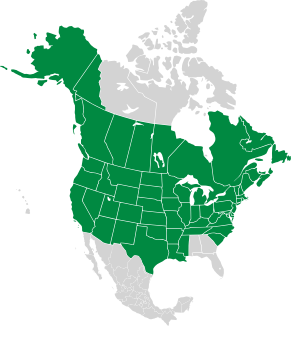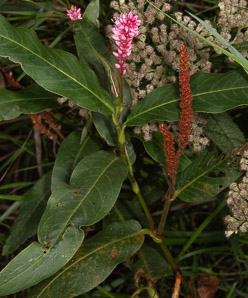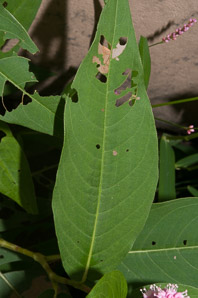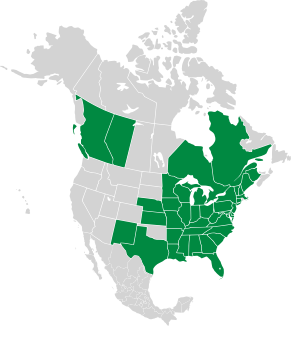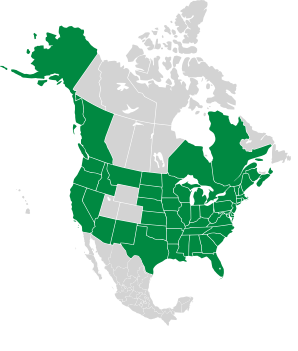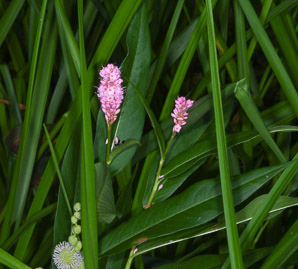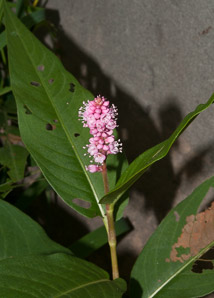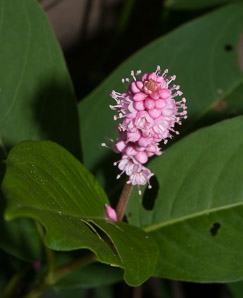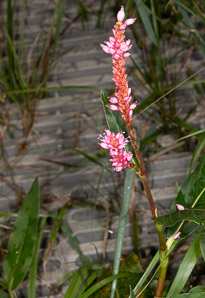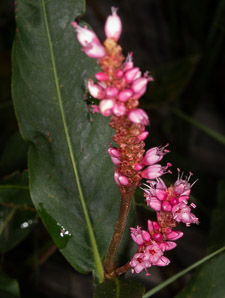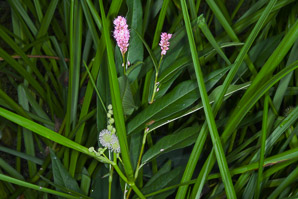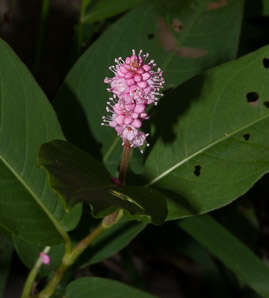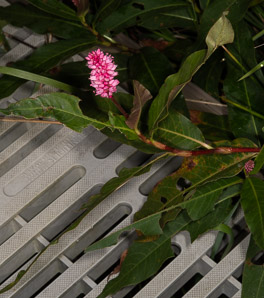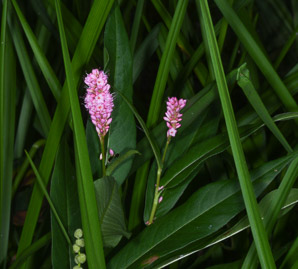
|
Polygonum amphibium L. Water smartweed, longroot smartweed, water knotweed, amphibious bistort
Water smartweed is native to much of North America, as well as Asia, Europe, and parts of Africa. Introduced elsewhere as well, it is sometimes considered a noxious weed. It is found floating in ponds, streams, and marshes. I first spied it while tubing down the Delaware river. Plants: Water smartweed roots extend thick stems which float or grow horizontally until they find a moist area, into which they extend new roots. Stems reach up to 9½′ (3 m) long and ⅜″ (1 cm) around. Leaves: Leaves are alternate, and often lanceolate, but they take on many other shapes. They may be floating or upright, with papery sheaths at leaf bases. They are ¾-8″ (2-20 cm) × ⅛-1¾″ (5-50 mm), with petioles 1/32-1″ (1-30 mm). Leaves are not mottled. Ocrea are ⅛-1¾″ (5-50 mm), with the upper part fringed with small hairs 1/32-⅛″ (0.5-4.5 mm) long. Flowers: Flowers are pink, appearing in a thick oval cluster of tiny five-lobed flowers. The cluster is ¾-6″ (2-15 cm) long. Each individual flower is ⅛-3/16″ (4-5 mm) in diameter. Flowers appear June to September. Fruits: Tiny brown rounded achenes 1/16-⅛″ (2.5-3 mm) long. Each achene contains one seed. They appear from July to September. Edibility: Young shoots are edible if used sparingly. Like many plants, they contain oxalic acid, which contributes bitterness and is toxic if eaten often or in large quantities. |
9/17/2023 · Sprague Pond Preserve, Basin Preserve, Phippsburg, Maine · ≈ 5 × 8″ (13 × 20 cm) 9/14/2013 · Whitewater Rafting Trip, Barryville to Pond Eddy Leg, Delaware River, Barryville, Pennsylvania · ≈ 4 × 6″ (11 × 16 cm) |
||||||||||||||||||||||||||||
|
| |||||||||||||||||||||||||||||
| You are here Polygonum amphibium |
Polygonum cespitosum |
Polygonum hydropiperoides |
|||||||||||||||||||||||||||
|---|---|---|---|---|---|---|---|---|---|---|---|---|---|---|---|---|---|---|---|---|---|---|---|---|---|---|---|---|---|
| Common Name |  |
 |
 |
||||||||||||||||||||||||||
| Plant | Up to 9½′ (3 m) × ⅜″ (1 cm), sprawling or floating. | Up to 3′ (91 cm) in size, sprawling or erect. | 6-39″ (15-100 cm) long, but slender and with upper portions usually erect, erect to sprawling. Stems are green to red. (Compare to P. amphibium, with stems up to ⅜″ (1 cm) around, and more often sprawled along the surface of the water). | ||||||||||||||||||||||||||
| Flowers | Pink, appearing in a thick oval cluster of tiny five-lobed flowers. The cluster is ¾-6″ (2-15 cm) long. Each individual flower is ⅛-3/16″ (4-5 mm) in diameter. Flowers appear June to September. | Pink/white flower spikes are ¾-1½″ (1.9-3.8 cm) tall × 1/16-3/16″ (3-6 mm) thick, densely filled with individual flowers less than ¼″ (6.3 mm) in size. (By contrast, P. persicaria has flower stalks ⅛-⅜″ (6-12 mm) thick.) Flowers appear from June to October. | Greenish, pinkish, or white flowers form loose, elongated spikes 1-3″ (3-8 cm) long and 1/16-⅛″ (2-5 mm) around. The spikes are on peduncles ⅜-1″ (1-3 cm) long. | ||||||||||||||||||||||||||
| Leaves | Alternate, and often lanceolate, but they take on many other shapes. They may be floating or upright, with papery sheaths at leaf bases. They are ¾-8″ (2-20 cm) × ⅛-1¾″ (5-50 mm), with petioles 1/32-1″ (1-30 mm). They are not mottled. | Alternate, elliptic to lanceolate, ¾-3″ (2-7.5 cm) × ⅜-1¼″ (1-3.5 cm), and pointed at the base and tip. Petioles are 1/32-⅛″ (1-5 mm). Leaves are not mottled. | Alternate, lanceolate, bristly, with smooth edges. Floating or upright, up to 1¾-6″ (5-15 cm) × ⅜-⅞″ (1-2.5 cm), tapering to a sharp point. Petioles are less than ⅛″ (5 mm) long. Leaves are not mottled. | ||||||||||||||||||||||||||
| Stem | Ocrea are ⅛-1¾″ (5-50 mm), with the upper part fringed with small hairs 0.5-4.5 mm long. | Ocrea encompassing the joints are long-bristly, and ⅛-⅜″ (4-12 mm) long,, vs. less than ⅛″ (5 mm) for P. persicaria. | Ocrea are brown, cylindric, and ⅛-⅞″ (5-23 mm) long, with an inflated base, topped with hairs 1/16-⅜″ (2-10 mm). | ||||||||||||||||||||||||||
| Fruit | Tiny brown rounded achenes 1/16-⅛″ (2.5-3 mm) long. Each achene contains one seed. They appear from July to September. | A black achene with a triangular cross section. | Dry, hard, smooth, shiny achenes each contain a single seed. They are 1/32-⅛″ (1.5-3 mm) long, and three-sided. | ||||||||||||||||||||||||||
| Range/ Zones |
|
|
|
||||||||||||||||||||||||||
| Habitats | Floating in ponds, streams, and marshes | Common to invasive in disturbed habitats such as pastures, roadsides, and lawns. It is partial to wet areas. | Often forming mats along lake or pond margins. | ||||||||||||||||||||||||||
| Type | Wild | Wild | Wild | ||||||||||||||||||||||||||
Polygonum lapathifolium
Polygonum persicaria


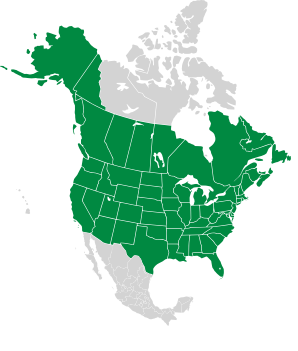

Online References:
The Washington State Department of Ecology
Plants for a Future, a resource and information centre for edible and otherwise useful plants
The Lady Bird Johnson Wildflower Center
References:
Clemants, Steven; Gracie, Carol, Wildflowers in the Field and Forest, Oxford University Press, 2006, p. 76
8/16/2016 · John Tinker Trail, Nashua River, Groton, Massachusetts 
9/14/2013 · Whitewater Rafting Trip, Barryville to Pond Eddy Leg, Delaware River, Barryville, Pennsylvania · ≈ 4 × 6″ (10 × 15 cm) 
9/14/2013 · Whitewater Rafting Trip, Barryville to Pond Eddy Leg, Delaware River, Barryville, Pennsylvania · ≈ 2½ × 4″ (7.3 × 11 cm) 
9/17/2023 · Sprague Pond Preserve, Basin Preserve, Phippsburg, Maine · ≈ 4½ × 7″ (12 × 18 cm) 
9/17/2023 · Sprague Pond Preserve, Basin Preserve, Phippsburg, Maine · ≈ 3½ × 5″ (9.2 × 13 cm) 
Polygonum amphibium description by Thomas H. Kent, last updated 17 Oct 2023.
© FloraFinder.org. All rights reserved.
8/16/2016 · John Tinker Trail, Nashua River, Groton, Massachusetts 
9/14/2013 · Whitewater Rafting Trip, Barryville to Pond Eddy Leg, Delaware River, Barryville, Pennsylvania · ≈ 5 × 3½″ (13 × 9.2 cm) 
9/17/2023 · Sprague Pond Preserve, Basin Preserve, Phippsburg, Maine · ≈ 6 × 10″ (16 × 24 cm) 
8/16/2016 · John Tinker Trail, Nashua River, Groton, Massachusetts 
Range:
